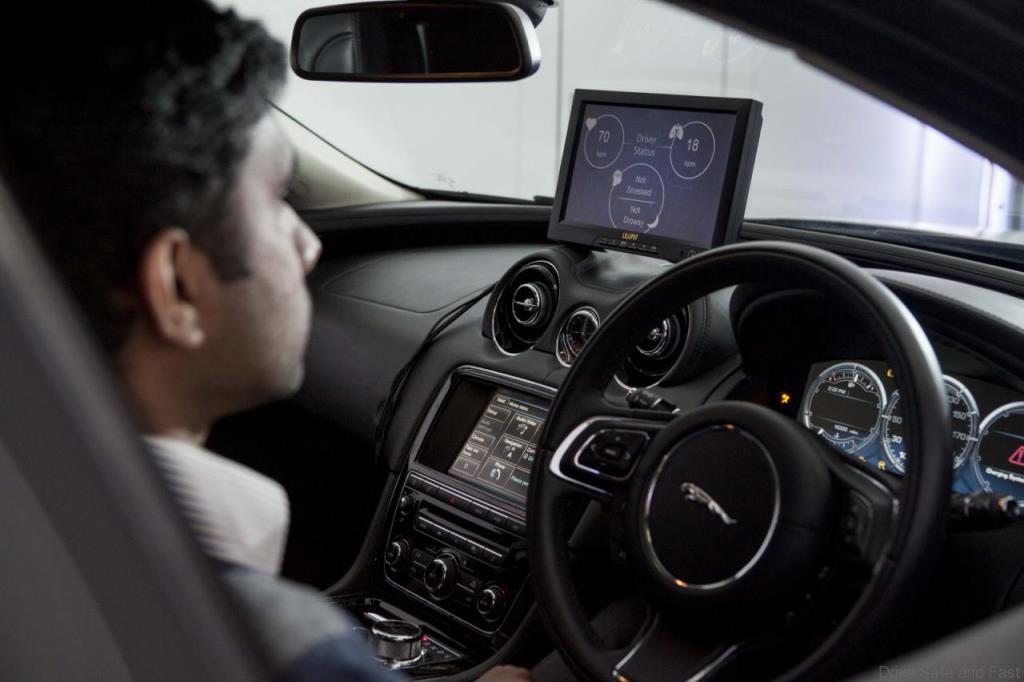Jaguar Land Rover has revealed a range of new road safety technology research projects that are being developed to reduce the number of accidents caused by drivers who are stressed, distracted and not concentrating on the road ahead.
The Jaguar Land Rover ‘Sixth Sense’ research projects utilises advanced technology, from sports, medicine and aerospace, to monitor the driver’s heart rate, respiration and levels of brain activity to identify driver stress, fatigue and lack of concentration. The UK-based team is also looking at innovations that would reduce the amount of time the driver’s eyes are off the road whilst driving, and how to communicate with the driver via pulses and vibrations through the accelerator pedal.
Dr Wolfgang Epple, Jaguar Land Rover Director of Research and Technology, said: “We believe some of the technologies currently being used in aerospace and medicine could help improve road safety and enhance the driving experience. The car is becoming more intelligent and more able to utilise cutting-edge sensors. These research projects are investigating how we could exploit this for the benefit of our customers and other road users.
The basis of Jaguar Land Rover’s Mind Sense research is to see if a car could effectively read the brainwaves that indicate a driver is beginning to daydream, or feeling sleepy, whilst driving.
The human brain continually generates four or more distinct brainwaves at different frequencies. By continually monitoring which type of brainwave is dominant, an on-board computer could potentially assess whether a driver is focused, daydreaming, sleepy, or distracted.
“If brain activity indicates a daydream or poor concentration, then the steering wheel or pedals could vibrate to raise the driver’s awareness and re-engage them with driving,” added Dr Epple. “If Mind Sense does not detect a surge in brain activity following the car displaying a warning icon or sound, then it could display it again, or communicate with the driver in a different way, to ensure the driver is made aware of a potential hazard.”
The most common method for monitoring brainwaves is close to the source using sensors attached to a headband, something that would be impractical in a vehicle. Jaguar Land Rover is investigating a method already used by NASA to develop a pilot’s concentration skills and also by the US bobsleigh team to enhance concentration and focus.
This detects brainwaves through the hands via sensors embedded in the steering wheel. Because the sensing is taking place further away from the driver’s head, software is used to amplify the signal and filter out the pure brainwave from any background ‘noise’. Jaguar Land Rover is currently conducting user trials to collect more information on the different brainwaves identified through the steering wheel sensors and will involve leading neuroscientists in the project to verify the results.
Jaguar Land Rover is assessing how a vehicle could monitor the well-being of the driver using a medical-grade sensor embedded in the seat of a Jaguar XJ. The sensor, which was originally developed for use in hospitals, has been adapted for in-car use and detects vibrations from the driver’s heart beat and breathing.
Monitoring the physical health of the driver could not only detect the onset of sudden and serious illness that may incapacitate the driver, but also allow the car to monitor driver stress levels. This would then allow the car to help reduce stress, for example by changing mood lighting, audio settings and climate control.
Jaguar Land Rover is working on new technologies that increase the speed and efficiency of the interaction between the driver and the infotainment screen. The aim is to reduce driver distraction by minimising the amount of time the driver’s eyes are on the screen.
Our Predictive Infotainment Screen prototype uses cameras embedded in the car to track the driver’s hand movements and this enables the system to predict which button the driver intends to press. This allows successful button selection to take place in mid-air, which means users wouldn’t have to touch the screen itself. In user trials this increases the speed of successful button selection by 22 per cent and therefore reduces the amount of time the driver is looking at the screen with their eyes off the road.
The system could also use mid-air touch to provide the driver with a sensation, otherwise known as haptic feedback, that their button selection has been successful. Mid-air touch uses ultrasonics to create a touch sensation in mid-air without the skin needing to be in contact with any surface. The sensations could include a ‘tap’ on your finger or a ‘tingling’ on your fingertips. As touch provides an immediate response to the brain, there will be no need for the driver to glance at the screen for visual confirmation which would help keep their gaze on the road ahead.
Haptics could also be used to communicate with the driver through the accelerator pedal to increase the speed of response and to ensure the correct action is taken.
To create these sensations in the accelerator pedal, an actuator sits at the top of the pedal arm and allows for vibrations or pulses to be passed through to the foot of the driver. The technology also uses a torque motor which can create resistance in the pedal feel.
This resistance could be used to notify the driver that they are pushing the accelerator through a speed limit. Alternatively, if you were crawling along in traffic a timely warning through the accelerator could prevent you bumping into the car in front.
Dr Epple added: “To avoid saturating the driver with more visuals and sounds, which could overload and distract them, we are exploring other ways for the car to communicate with the driver. With our haptic pedals researchwe are investigating non-visual ways to communicate which would enable the driver to make smarter and faster decisions and reduce the potential for accidents.”











